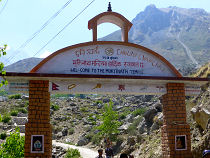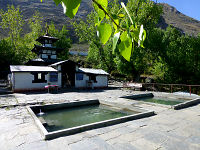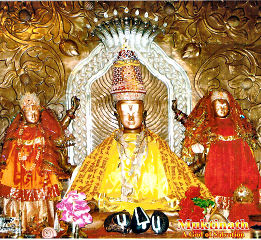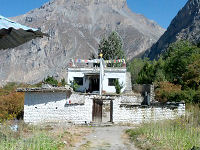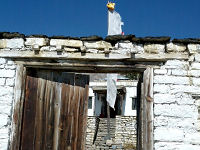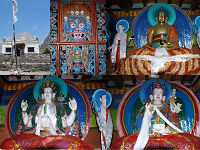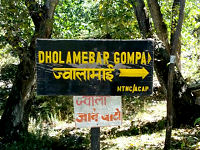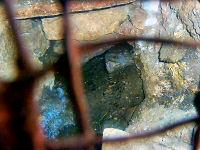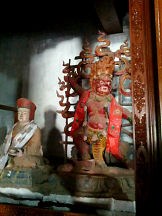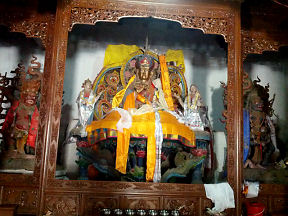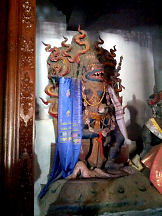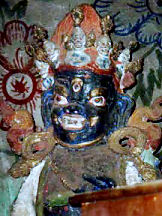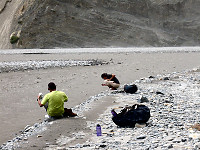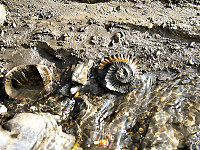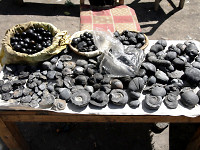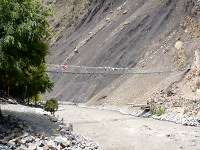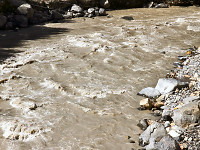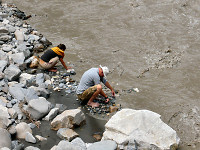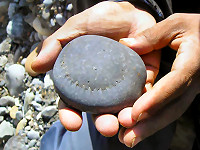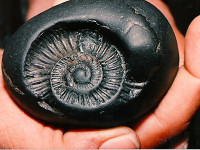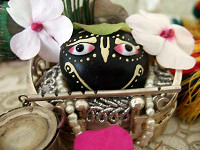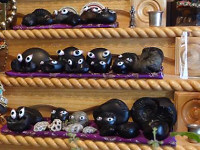
OM MANI PADME HUM |
||
ANNAPURNA CIRCUIT BASECAMP TREKKING Pokhara - Tatopani - Kagbeni - Jomson - Muktinath Śrī Muktināth Thīrthayātrī Sant Sevāśram |
||
Śrī Muktināth Kṣetra - Temple Shrines and Surrounding
The Muktināth Temple Area is a big complex consisting of many shrines with Muktināth temple in the middle. There is an impressive gate with Garuḍa along with his consorts welcoming all those want liberation. The whole compound is now surrounded by a compound wall which was built in 2003 by the devotees of Swami Narayan, who practiced severe penance here at Muktināth. There are many monasteries and Gompas around the Muktinath temple.
As you enter the walled complex, lined by Tibetan-style prayer wheels, you pass first the Gompa Sambha (First Monastery) on the left and then a Shiva Temple ringed by four smaller shrines. The focal point oft the complex is the Mukti-Kunda pool and its 108 brass waterspouts, cast in the shape of 'cows' heads, which pour forth sacred water. Usually pilgrims bathe in the frigid waters.
In front of Muktinath Temple there are 2 Kunda (Water ponds), named after Goddess Laxmi and Saraswati Kunda. It is also called Mukti-Kunda. It is believed that a holy dip in the water can wash away all the negative karmas, the results of one's past negative actions.
Behind the Muktinath temple there are 108 waterspouts (Dhara) called "Muktidhara".
Since 'Mukti' means liberation and 'Dhara' means water-spouts, pilgrims belive that it brings them salvation or Moksa by taking bath under the chilled water of the 108 water-spouts.
The 108 faucets, in the shape of 'cows' heads, pour fourth-sacred water closely arranged in a semi-circle with a gap of hardly a foot between the faucets, at a height of about seven feet. The water from Gandaki River continuously flowing through the mouth of the cows head. Pilgrims who visit the temple take a holy bath under each of these spouts. But as the water is ice cold it requires courage to take a holy bath here. Taking bath is therefore usually done at high speed, due to the frigid temperatures :-) Those who are unable to take bath, will take some holy water in their cupped palm and tossed it over the head for purification. You may find pilgrims bottling some of the sacred water to take back to their family, especially if anyone is sick or suffering ill fortune. Also pilgrims fill their bottles with the holy water, for Puja and also for drinking. » more here «
Muktinath, or Sri Muktinath, is a name of Lord Vishnu and means "the Lord of Liberation" granting liberation from the cycle of repeated birth and death (Samsara). 'Mukti' means liberation and "Natha" means Lord.
Mukti-kshetra, the "place of salvation", is the abode of Sri Muktinath (Vishnu), along with with Laksmi (Bhumi-Devi) and Sarasvati (Sri-Devi). Also Janaki and Garuda, Lava-Kusa and the Sapta Rishis are present.
Muktinath is one of the most-visited tirthas in Nepal, revered by both Hindus and Buddhists, and the glories of Muktinath are sung in the Vishnu Purana. Located in Muktinath Valley, 140 miles from Kathmandu, the temple is situated at the foot of Thorong La mountain pass, over 12,000 feet (3,700 meters) above sea level. » more here «
Samba Gompa (Sarwa Sangdo Gompa):
As soon as you enter through the main entrance gate of Muktinath temple complex, on the left is a brightly painted, big prayer wheel. Soon after on the same side, is a sign board indicating Samba Gompa.
Gompa Samba means "new monastery". It is believed that founder of this monastery Syandol Lama came from Tibet. Originally this monastery was a big hostel for lamas that later collapsed and people of Khinga and Jharkot jointly reconstructed it as the new monastary. The main deities of this monastery are Sakyamuni Buddha in the center with Avalokiteshwar or Chenresig on his right and Guru Rinpoche (Padmasambhava) on the left.
Muktinath Yagna-Sala (Yagyashala):
Muktinath Yajñaśālā (यज्ञशाला) is a place where rituals and prayers are performed around the holy fire.
In front of this building the board with the Sweet Tamil hymns of Thirumangai Azhwar is kept.
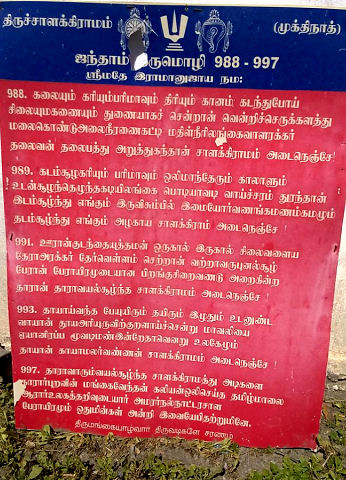 |
Vishnu-Paduka Mandir, or the temple of lord Vishnus lotus feet, is a small shrine on the right side on the way to the main Muktināth Temple. It contains an imprint of Lord Vishnus feet as well as an image of Nilkant Varni (Svāmī-Nārāyaṇ) a child yogi who is standing on one leg for severe meditation.
The marble pavilion 'Viṣṇu Padukā Mandir' (Swami Nārāyan Memorial) in the premises of Muktināth temple. Build in the Gujarāti style, it was donated by devotees of Svāmī-Nārāyaṇa.
The memorial panel tells of the child-yogi Nilkanth Varni who travelled throughout the Indian Himalayas, barefoot and only clad in loincloth. In the year 1849 vikram samvat, which corresponds to the year 1792 A.D. of our western calendar, Nilkanth Varni was doing severe austerities in Muktināth, standing on one leg for two months and 20 days. Later he became known as Svāminārāyaṇa.
In 2003 his followers funded the new wall around Muktināth and raised a small monument for him called the Viṣṇu Padukā Mandir (Swami Nārāyan Memorial).
The Shiva temple lies to the left of the entrance while going towards the main Muktinath temple.
The Shiva Paravati Temple, dedicated to Lord Shiva, with goddess Paravati is surrounded by four small shrines. Clockwise at the front left, the temple of Vishnu, behind it the temple of Lord Rama, next to it the temple of Lord Krishna, and at the right is the temple of Ganesha, son of Shiva and Parvati. A very small Nandi sits outside the temple, guarding the entrance.
Jwala Mai Temple - the temple of the eternal flame
Jwala Mai (lit. goddess of fire) is the temple of the eternal flame, wich is located inside the Tibetan style Dhola Mebar Gompa, situated to the east of the main Muktinath temple. It is built above an underground water stream, and small natural gas jets underneath the gompa produce continuously burning flames on top of the water. The holy flame alongside a spring, in combination with earth, water, fire and air, seems to be the origin of the religious significance of Muktinath, becauese only here all the elements are present in one spot. » more here «
Narsingh Gompa (Mharme Lha Khang)
The Mharme Lha Khang Gompa (which translates as thousand holy lamps) lies to the north-west of the main Muktinath temple, and contains the statue of famous Guru Rinpoche (Padmasambhava). As this monastery is dedicated to Guru Rinpoche, his huge clay image is placed at centre of altar along with the Bon deities: red Dragpo at the right side and blue Senge Dongma at the left side.
Senge Dongma, a lion-headed wrathful deity, is also worshipped by Hindus as Narsimha, the half man and half lion avatar of Vishnu. Hence, the monastery is also called Narsingh Gompa (नरसिंह गोम्पा). The lion faced Narsimha deity, (Simhamukha or 'Senge Dongma' snow lion) removes all obstacles and is a great protector of his devotees.
Drag (drag-po) means "fierce", and refers to the wrathful form of Padmasambhava known as Guru Dragpo, who is flaming red in color, attired as a wrathful deity, holding a vajra in his right hand and a black scorpion in his left. And 'seng' means "lion", and refers to the lion-headed Deity Simhamukha (Senge Dongma).
Another attraction for the pilgrimage to Muktinath is the River Kali Gandaki from where one can collect the sacred ammonite fossils called Shaligram. Shaligram is also known as Shaligram Shila. The "shila" meaning the sacred form of lord as a black stone pebble. Shaligram-Shila, Salagram-Sila or Shalagrama, are all synonymous.
The Śālagrāma-Śilā (शालग्राम-शिला), the sacred black stone, is worshipped by Vaishnava Devotees, Brahmanas and devout Hindus and is only found in Kali-Gandaki river (oldest name – Krishna Gandaki river) which is situated in western part of Nepal.
The Shalagrama is the most sacred stone worshipped by the Vaishnavas and is used to specially worship Vishnu. According to the Vaishnavas the Shaligram is the "dwelling place (or seat) of Lord Vishnu". Like the worship of Shiva in the form of a Linga, so is the worship of Vishnu in the shape of a Shalagram.
Villages in the Muktinath Valley
The Muktinath valley has seven historic famous villages: Ranipauwa, Putak, Jhong or Dzong, Chhyokhar or Chongur, Purang, Jharkot and Khinga.
Khinga |
Ranipauwa |
Purang |
Jharkot |
Chongur |
Jhong-Dzong |
Jhong-Monastary |
Putak |
The settlement of Ranipauwa got its name from a huge pilgrims house donated by queen Subarna Prabha Devi. Since 'Rani' means queen and 'pauwa' pilgrims shelter, the village was named Ranipauwa, which sometimes is mistakenly called Muktinath. Actually Muktinath is above Ranupauwa and it takes 20 min. to walk from Ranipauwa to the temple of Muktinath. » «
